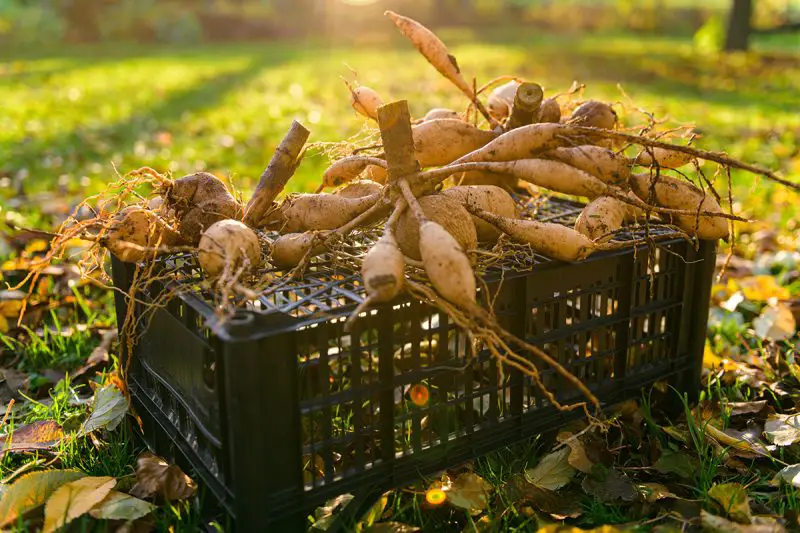Dahlia tubers are the hidden treasures beneath the soil that allow these beautiful summer flowers to return year after year. If you want to enjoy vibrant blooms in your garden again next season, knowing how to store dahlia tubers for next season is essential. Proper storage not only preserves their health but also prevents rot, mold, and sprouting during the off-season.
Storing dahlia tubers the right way ensures they survive the cold months and remain viable for replanting in spring. Many gardeners lose tubers over winter due to moisture, freezing temperatures, or improper handling. With the right technique, your tubers can be kept dormant, disease-free, and ready to grow again when the weather warms.
In this guide, we’ll cover every step of the storage process in detail, from when and how to dig them up, to drying, curing, and the best environment to keep them safe until the next planting season. Whether you’re a first-time grower or a seasoned flower enthusiast, learning how to store your dahlia tubers properly will help you grow stronger, more vibrant plants next year.
Understanding Why Dahlia Tubers Need Storage

Dahlias Are Not Cold-Hardy
Dahlias are native to warm climates and cannot survive freezing temperatures. In most USDA zones below 8, the winter frost will damage or kill dahlia tubers if left in the ground. That’s why gardeners in cooler regions must dig up and store their tubers at the end of the growing season.
While some areas with mild winters may allow dahlias to overwinter in the ground with heavy mulching, this method still carries a risk. For those who want to be certain their tubers survive, digging and storing is the most reliable option.
Storing Tubers Preserves Your Favorite Varieties
Many dahlia varieties are rare or expensive, making it worth the effort to preserve your tubers for the following year. Storing them allows you to grow your favorite colors and forms again without needing to purchase new plants each spring.
By taking care of your existing tubers, you also ensure consistency in your garden’s design. You can plan your layouts and borders with confidence, knowing that the same healthy plants will return and thrive.
Proper Storage Reduces Loss and Waste
Improperly stored dahlia tubers are prone to rot, mold, or shriveling. When tubers are exposed to too much moisture, they may become soft and start to decay. If they are kept too dry or in poor conditions, they may dry out completely and fail to sprout.
Learning how to store dahlia tubers correctly helps you avoid these common problems. It saves time, money, and frustration, especially when preparing your garden next spring.
When to Dig Up Dahlia Tubers
Wait Until After the First Frost
The best time to dig up dahlia tubers is shortly after the first killing frost in your area. When frost blackens the foliage, it’s a signal that the growing season is over. This also means the tubers have reached full maturity and are ready for storage.
If you dig too early, before the plants naturally die back, the tubers may not be fully developed. Waiting until frost gives the plant enough time to store energy in the roots, improving the tuber’s chances of survival through winter.
Choose a Dry Day for Digging
Try to dig up your tubers on a dry day when the soil is not soggy. Wet soil increases the chances of rot and makes cleaning more difficult. Working in drier conditions also helps preserve the integrity of the tubers and prevents accidental breakage.
Gently loosen the soil around the base of each plant using a garden fork or spade. Lift the entire clump carefully to avoid damaging the necks of the tubers, which are sensitive and prone to rot if broken.
Label Each Variety Immediately
Once the tubers are out of the ground, it’s important to label them right away. Many dahlia varieties look similar once their foliage is gone, so keeping track of their names or bloom colors can save confusion when it’s time to replant.
Use garden tags, write directly on the stems with a waterproof marker, or keep a log of your varieties. Labeling ensures you maintain a clear inventory of what you have and where you want to plant it next season.
Cleaning and Preparing Dahlia Tubers for Storage
Remove Excess Soil Gently
After lifting your tubers from the ground, shake off loose soil carefully. Do not wash them immediately, especially if they are still moist or the day is damp. Wet tubers are more likely to develop fungal issues if stored without drying properly.
You can remove dry soil by brushing it away with your hands or a soft cloth. Take care not to break or bruise the tubers during this step, as any damage can invite disease during storage.
Trim Foliage and Stems
Cut the stems back to about two to four inches above the tuber crown. Leaving a bit of the stem helps protect the neck area and prevents the tuber from drying out too quickly.
Removing the remaining foliage also limits the risk of decay and prepares the tubers for the drying process. Some gardeners also choose to trim off small feeder roots at this stage to make handling and storage easier.
Inspect Tubers for Damage or Disease
Before storing, take time to examine each tuber carefully. Look for signs of rot, mold, softness, or pest damage. Discard any tubers that are clearly diseased or broken beyond repair. Keeping unhealthy tubers in storage can lead to the spread of disease to healthy ones.
If a tuber has minor damage, you can sometimes salvage it by cutting away the affected area and letting the cut dry completely before storing. Make sure any tool used is clean and sterilized to prevent contamination.
How to Cure Dahlia Tubers Before Storage
The Purpose of Curing
Curing is the process of allowing the outer skin of the tuber to dry and harden slightly before storage. This step reduces the risk of rot and gives any minor cuts or bruises time to seal.
Proper curing conditions include moderate temperatures and good air circulation. The goal is to remove surface moisture while maintaining internal moisture so the tubers do not dry out entirely.
Curing Setup and Timing
Place tubers in a single layer in a shaded, well-ventilated area. A garage, covered porch, or basement can work well if humidity is low. Avoid direct sunlight, which can dehydrate and damage the tubers.
Cure your tubers for around one week. During this time, check them daily for soft spots or mold. If any issues appear, separate the affected tubers to prevent problems from spreading.
Once the skins feel dry and slightly toughened, your tubers are ready to be packed and stored for the season.
Choosing the Right Storage Environment
Ideal Temperature and Humidity
Dahlia tubers should be stored in a cool, dark location where temperatures stay between 40°F and 50°F. Higher temperatures may cause sprouting, while freezing conditions will damage the tubers.
Humidity levels should be moderate, around 70 to 80 percent. Too much humidity leads to mold and rot, while low humidity causes the tubers to shrivel and dry out. A balance is key to keeping them dormant yet alive.
Basements, root cellars, unheated garages, and cool closets are commonly used for storage. The location you choose should remain stable throughout the winter.
Packing Methods for Tubers
There are several methods you can use to pack dahlia tubers for storage, depending on your space and available materials. The goal of each method is to prevent the tubers from drying out too much or sitting in moisture.
Some gardeners wrap each tuber in newspaper before placing them in cardboard boxes. Others prefer packing in slightly damp peat moss, vermiculite, or wood shavings to help retain just enough moisture.
No matter the material, keep the tubers from touching one another too closely. Good airflow reduces the risk of one bad tuber spoiling others around it.
Periodic Checks During Winter
Storing your tubers is not a one-and-done task. It’s important to inspect them periodically throughout the winter. Every three to four weeks, check for signs of rot, mold, shriveling, or premature sprouting.
Remove any tubers that are clearly rotting or infected. If others look a bit dry, you can lightly mist your packing material, but don’t overdo it. Adjust your storage conditions if you notice consistent issues with moisture or dryness.
Monitoring your tubers increases the success rate and ensures you have healthy roots to plant when spring arrives.
Getting Tubers Ready for Spring Planting
Waking Up Dormant Tubers
As winter ends and temperatures begin to rise, you can start waking up your dahlia tubers. Bring them out of storage and let them adjust to room temperature for several days. This gradual transition helps prepare them for new growth.
Look for signs of healthy eyes or buds forming near the crown. These are indicators that the tuber is still viable and ready to grow.
If a tuber remains firm but shows no signs of sprouting, be patient. Some tubers take longer to wake up depending on the variety and storage conditions.
Dividing Tubers for Propagation
Spring is also the best time to divide your tubers if you want to multiply your stock. Each division should include at least one healthy eye and a portion of the tuber.
Use a clean, sharp knife to make the cuts, then let the pieces dry for a day before planting. This allows any wounds to callous and reduces the risk of rot after planting.
Dividing is a great way to expand your collection and share your favorite varieties with fellow gardeners.
Replanting for the New Season
Once the soil has warmed and the danger of frost has passed, it’s time to plant your tubers. Choose a sunny location with well-draining soil and enrich the area with compost before planting.
Place each tuber horizontally with the eye facing up, cover with soil, and water lightly. Soon, fresh shoots will emerge, signaling the start of another season of spectacular dahlias.
FAQ About How to Store Dahlia Tubers
When should I dig up dahlia tubers for storage?
The best time to dig up dahlia tubers is right after the first killing frost in the fall. The frost will blacken the foliage, signaling that the growing season is over and the tubers are mature enough for storage.
Should I wash the tubers before storing them?
It’s best to shake off excess soil gently and let the tubers dry before washing. Washing is optional and only recommended if you allow them to fully dry afterward. Wet tubers stored too soon are more likely to rot.
How long should I cure dahlia tubers before storing them?
Cure the tubers in a cool, shaded, and well-ventilated space for about one week. This allows the skin to harden and any small wounds to heal before placing them in long-term storage.
What temperature is ideal for storing dahlia tubers?
Tubers should be stored in a location where temperatures stay between 40°F and 50°F (4°C to 10°C). Avoid areas that are too warm or that drop below freezing.
What can I use to pack dahlia tubers for storage?
You can pack tubers in slightly damp peat moss, vermiculite, sawdust, or even newspaper. The material should keep the tubers from drying out completely while allowing air circulation to prevent mold.
How often should I check on my stored dahlia tubers?
Inspect your stored tubers every 3 to 4 weeks during winter. Look for signs of rot, mold, or dryness. Remove any soft or shriveled tubers to prevent problems from spreading.
Can I store dahlia tubers in plastic bags or containers?
Avoid sealing tubers in airtight plastic bags, as this traps moisture and promotes rot. If using containers, make sure they allow some airflow. Ventilation is key to preventing moisture buildup.
How do I know if a stored tuber is still alive in spring?
Healthy tubers will be firm and may show tiny buds or “eyes” near the crown. If the tuber is completely soft, hollow, or moldy, it is no longer viable and should be discarded.
Final Thoughts on How to Store Dahlia Tubers for Next Season
Learning how to store dahlia tubers for next season is one of the most rewarding skills a flower gardener can master. With a little care and attention, you can protect your tubers through the cold months and enjoy a fresh, vibrant bloom when spring returns.
By digging them up at the right time, cleaning and curing properly, packing with care, and storing under the right conditions, you give your dahlias the best chance to thrive again. Checking on them through the winter and preparing them properly for planting ensures strong, beautiful growth year after year.
With proper storage, your dahlias will not only survive — they’ll come back stronger, fuller, and even more beautiful than before.






